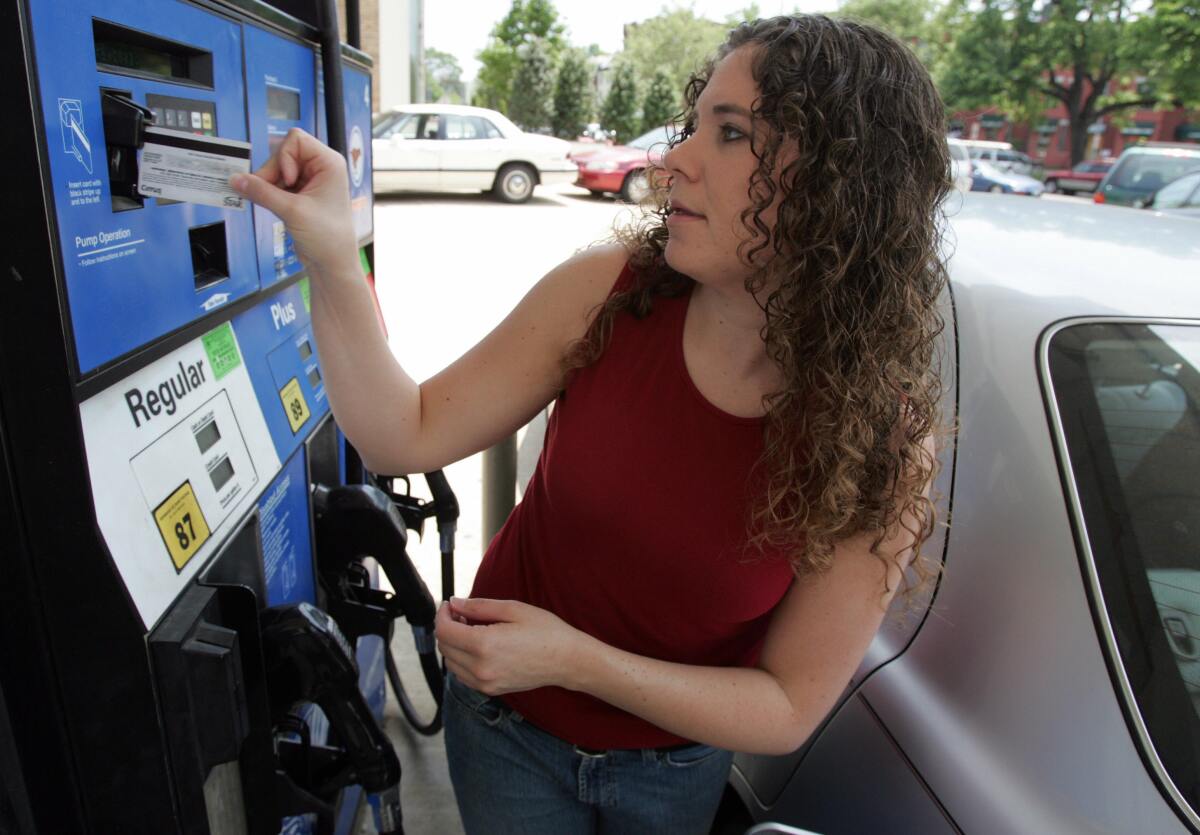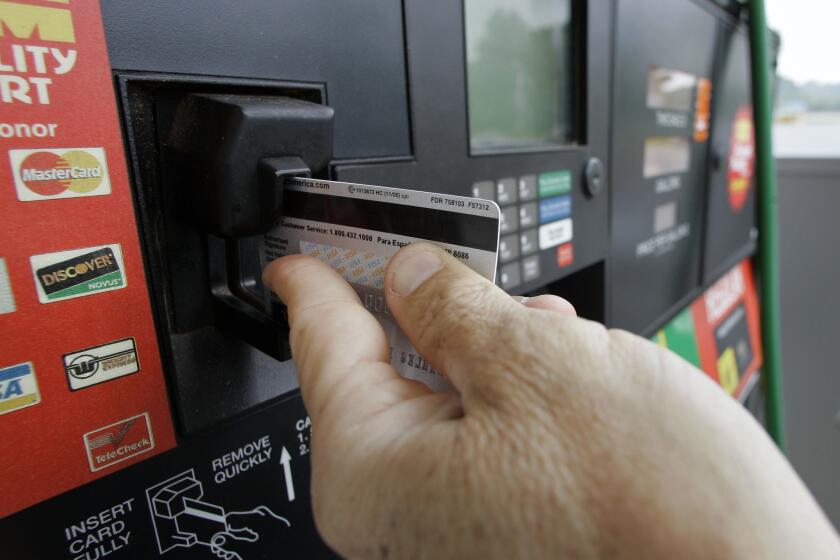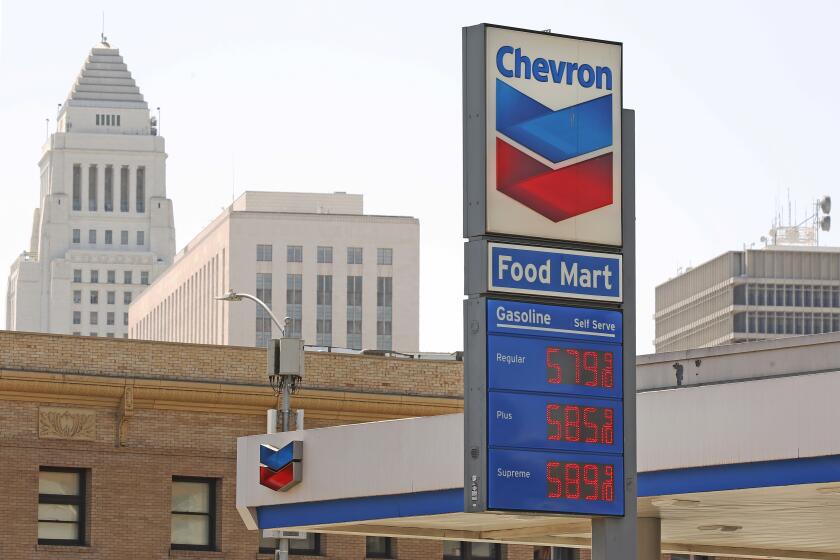Gas stations rush to adopt chip-card readers at fuel pumps

- Share via
Gas stations nationwide are rushing to upgrade fuel pumps to accept credit and debit cards with chips after Visa Inc. and Mastercard Inc. rejected a request to delay a looming deadline to complete the work.
Beginning in October, U.S. gas station operators that haven’t modernized their pumps will face liability for any card fraud that happens at their businesses. The industry is “massively underprepared,” said Joshua Smith, chief executive of Gas Pos, which sells point-of-sale systems.
“There’s not enough technicians to do the installments,” Smith said. “There’s not enough inventory. Even if there were enough contractors, there’s not enough dispensers available.”
Most retailers began to upgrade payment systems in 2015 — the first of a series of deadlines set by Visa and Mastercard as the United States worked to catch up with nations in Europe and Asia that had long ago adopted the more-secure chip cards. For fuel retailers, the deadline was ultimately pushed back five years as the industry faced costs of more than $3.9 billion to do the work.
In a 2019 survey by Conexxus, a nonprofit that represents convenience stores, almost 70% of respondents who own a convenience store said they hadn’t upgraded any outside pumps to the chip-card technology, known as EMV.
Most U.S. retailers switched to chip-card readers long ago. Now Visa is warning of fraud risks at gas pumps’ swipe-card readers.
Few companies manufacture the required pumps. Those that do — such as Dover Corp. or Fortive Corp.’s Gilbarco Veeder-Root — have said they’re expecting an increase in sales ahead of the deadline. Once the hardware is installed, fuel companies must have the pump software certified.
Fuel retailers that don’t upgrade could face costs of as much as $201,000 per store over the next seven years, according to data compiled by Conexxus. The group expects the fuel industry to suffer $451 million of card fraud in 2020 alone.
“There’s going to be quite a surprise come October,” Laura Townsend, senior vice president of the Merchant Advisory Group, said in an interview. “Folks that have been trying to transition to EMV will be unable to because of things outside their control. But they will bear a significant increase in losses either come October or shortly thereafter because we know fraudsters will find the weakest link.”
More than half of participants in the Conexxus survey cited a lack of available software for not having chip technology fully deployed, while about 15% pointed to a shortage of hardware. The convenience-store industry blames Visa and Mastercard for not consulting them when setting deadlines.
“The payment standard-setting process needs to be more open,” said Anna Ready Blom, director of government relations for NACS, a trade association for the convenience-store industry. “Retailers and technology companies should have been part of the planning and decision-making on chip cards from the start. If they had been, rather than Visa and Mastercard making all the decisions without understanding them fully, we wouldn’t be in this mess.”
It’s not your imagination. Energy experts say it’s common for gas prices to rise quickly when oil markets are disrupted and then take their sweet time returning to normal.
Visa and Mastercard aren’t willing to give gas stations more time. The networks recently rejected a plea for a delay from the Merchant Advisory Group, which helps retailers navigate payment-systems issues.
“We believe extending chip technology to fuel pumps is an important step to take to protect businesses and consumers who want to pay securely as well as conveniently,” Visa said in a statement. Mastercard said it’s seeing good adoption of EMV technology and a reduction in fraud.
Visa and Mastercard began calling for a migration to chips years ago to head off counterfeit-card fraud. The underlying technology — called EMV for founders Europay, Mastercard and Visa — generates new codes for each transaction, while the information on magnetic stripes is permanent and can be copied and stored by hackers.
More than 3.7 million merchants — or 80% of U.S. storefronts — currently accept chip cards. Since 2015, the amount of money merchants lost to counterfeit fraud has dropped 62%, according to Visa.
As gas stations start to make the switch, they’re also facing an increased threat from hackers looking to take advantage of one of the last industries that remains vulnerable to counterfeit-card fraud.
“As long as the magnetic stripe readers are in place, fuel dispenser merchants are becoming an increasingly attractive target for advanced threat actors,” Visa said in a security alert issued in November. It recommended these merchants deploy chip acceptance along with other security measures such as encryption and educating employees about phishing attacks.
Surane writes for Bloomberg.








